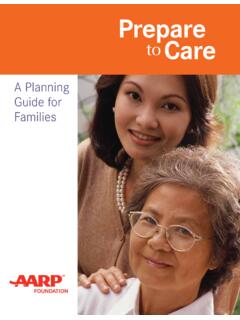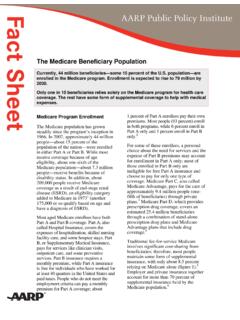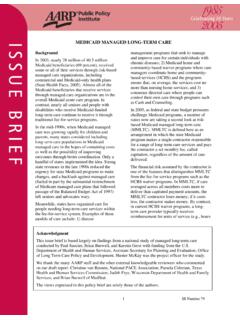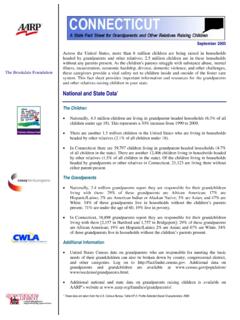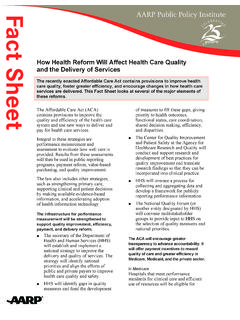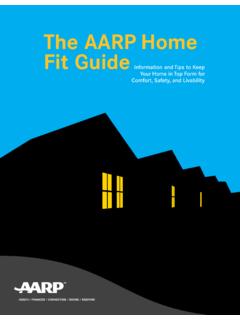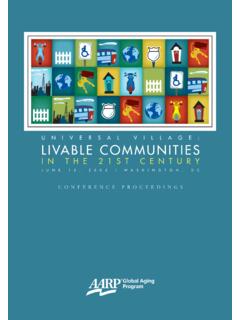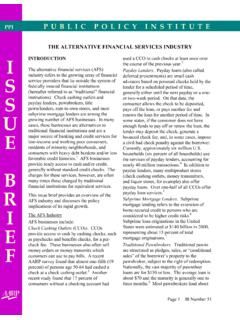Transcription of A Planning Guide for Families - AARP
1 A PlanningGuide forFamiliesTABLEOFCONTENTSI ntroductionIVStep 1: Prepare toTalk3 Step 2: Form YourTeam7 Step 3: Assess Needs8 Step 4: Make a Plan27 Step 5: Take Action28 Introduction1 IVSo why not just throw this brochure on the to do pile foranotherday? Because failing to plan for future responsibilities can make a badsituation worse. And the loved ones you tried to protect by tip-toeing around uncomfortable issues will be the ones who endup suffering the you might not be thinking about it now, putting together acaregiving plan with your loved ones and other family membershelps eliminate problems at home and work. In addition to mini-mizing the last minute scrambling and family tensions that com-monly arise when a once-independent loved one needs moreconsistent care , a caregiving plan can also help reduce a family sfinancial strain. The truth is that family caregiving responsibilities take a toll onfamily finances.
2 A study by the MetLife Mature Market Institute,for example, found that caregiver respondents reported anaverage loss of $566,443 in wage wealth all because of the unan-ticipated consequences of their caregiving s not just the caregivers who are affected. Without a caregivingplan, those family members most affected by the crisis the carerecipients themselves end up with the least say in their wishesand priorities for the future. It s hard to imagine not having con-trol over your own future, but too often that is what happenswhen Families don t ask the important questions ahead of time. Thinka caregiving crisis won t happen to yourfamily? Today, 30 million households are providing care for an adult overthe age of 50 and that number is expected to double over thenext 25 years. For many Americans, life at 40, 50 or even 60 yearsold will include care for an aging parent or relative. As the nationgrows older, the need for caregiving will be as common as theneed for child you have not yet begun to discuss a caregiving plan with yourloved ones and other members of your family, it is never too doesn t matter who starts the conversation.
3 What really mattersis that every American family has the opportunity to talk aboutand create a caregiving plan for their aging loved ones based onthe needs and wishes of those who will be receiving the care . Saving for a in a Americans understand why it s important to planfor the future. But when it comes to caring for an aging loved one,most Families don t have a plan until there is a of Planning doesn t mean there is a lack of commitment. Onthe contrary, often Families avoid discussions about the futuresimply because they don t want to think about changes in the livesof the people they love the most. Like writing a will or buying a life insurance policy, contemplatingthe what if s, especially a serious illness or a loss of independ-ence, can be downright depressing. When I really getdown to it,it salmostimpossibleto believe thatmydad may need whole life,he s always beenthe one thattookcare ofme. 32 STEP1 Prepare toTalkLet s face it.
4 No adult child wants to talk about the what if s with their fiercely independent no parent wants to admit to themselves ortheir children that they might need help someday. So before you figure out who will care for your lovedone, it s important to ask yourself some questions: Who is the best person to start the conversationwith your loved one(s)? What are your biggest concerns and prioritiesas you help put together a caregiving plan forsomeone else? What is the best thing you think might happenas a result of this conversation? What is the most difficult thing for you about having this conversation with a person you careabout? What are you afraid might happen as a result ofthis conversation? How do you think your loved one and otherfamily members might react to the conversa-tion? How does your family usually respond whenuncomfortable subjects are discussed? How can you explain to your loved one andother family members why it is important tohave this conversation?
5 In addition to emotional support, how muchfinancial support are you willing or able to pro-vide if your loved one needs it? (You might startby reviewing The Financial Steps for Caregivers:What You Need to Know About Money andRetirement, from the Women s Institute for aSecure Retirement at ).Five Steps to a Caregiving PlanforYourFamilyThis Guide is designed to help you and other familymembers discuss and create a caregiving plan for your-self or an aging parent, other relative, or close friend orneighbor. Each of the following five steps includesinformation on how to get started, questions to ask, and where to find basic resources. Don t be discouragedif you can t answer every question or fill in every remember, you don t have to do it all at once. Theimportant thing is to start and continue the conver-sation in a way that works for you and your family. STEP1 Prepare to TalkSTEP2 Form YourTeamSTEP3 Assess NeedsSTEP4 Make a PlanSTEP5 Take ActionThe Opinion That Matters MostEvery caregiving plan mustbegrounded in the wishes and con-sentofthe person(s) who will bereceiving the care .
6 It s still impor-tantforcaregivers to evaluatetheirown values,responsibilities,and finances,but they shouldnevermake a plan orinter-vene in the lives oftheirlovedones without is importantnotonly to protectthe interests andneeds ofthe person being caredfor,butalso because the caregivercould getinto legal trouble iftheydo nothave the legal authority toacton behalfofa loved one. Keepin mind thateven ifa family hasgood intentions,financial institu-tions,courts,and eldercare serv-ices are mindful ofpotential elderabuse,fraud,and neglect,and willexpectproofoflegal Tips on How to Approach a Difficult TopicThe reality is that some conversations are just plain difficult even with the people to whom you feel the closest. Whenpreparing to discuss a difficult topic, it helps to follow the groundrules below to ensure that everyone s feelings are respected andviewpoints are heard. To help make the conversation as productive and positive as not to approach the conversation with preconceived ideasabout what your loved ones might say or how they might react.
7 Dad,I just wanted to have a talk about what you sjust start with what is important to you. the conversation with an attitude of listening nottelling. Dad,have you thought about what you want to do ifyou needed more help? as opposed to We really need to talkabout a plan if you get sick. references to yourself and your own thoughts aboutwhat you want for the future. Let them know that they are notalone; that everyone will have to make these decisions. Look,Iknow this isn t fun to think about or talk about,but I reallywant to know what s important to m going to do the samething for myself. very straightforward with thefacts. Do not hide negative infor-mation, but also be sure toacknowledge and build on familystrengths. As time goes on,itmight be difficult to stay in thishouse because of all the stairs,butyou have other s talkabout what those might be. your concerns as ques-tions, letting your loved onesdraw conclusions and make thechoices.
8 Mom,do you think youmight want a hand with some ofthe housekeeping or shopping? Understanding YourLoved Ones Goals forthe FutureYour conversation about the future doesn t have to focus only on acaregiving plan. You may also consider talking generally with yourloved ones about what is most important to them as they growolder. You can use the following checklist as a starting point tobetter understand their priorities. Start by asking them to checkall those that apply and then spend some time talking about eachone in a little more detail. _____To remain as independentas possible foras long as possible_____To remain healthy and active_____To remain in my own home foras long as possible_____To focus on a hobby ofmine_____To workforas long as possible_____To become involved in the community_____To remain as financially independentas possible_____To take classes_____To create a safety netin the eventofan emergency orcrisis situation_____To startmy own business_____To buy a second home_____To move closerto family_____To relocate to a smallerhome_____To retire in a differentplace_____To travel_____To be able to help my children and grandchildren45 The conversationabout caregiving is more than is adiscussion thattakes place is nevertoo early to starttalking.
9 Every time I try tobring up the future,my dad justshutsdown. He tells methe importantpapers are in thefile cabinet,buttheconversation neverseems to go beyondthat. STEP2 Form YourTeamYou can t create an effective family caregivingplan without the input and support of yourloved ones and your other family members everyone should have a say in the are you already have an idea of whoneeds to be in on the conversation, but it helpsto list everyone who should and would want tobe a part of the team. That includes difficult or argumentative family members. It might beeasier to leave them out of the initial discus-sion, but it won t help later when it s time toput the plan into action. Before you sit down to talk about the next steps,you need to assemble your team thosefamily members (and perhaps some closefriends) who want or need to play a role in the caregiving plan. Themost important and unfortunately often the most overlooked participant in the conversation is the person who may be on thereceiving end of the care .
10 Barring mental or physical incapacity orother extraordinary circumstances, the person receiving the careshould play the most significant role in the discussion. The care recipient s wishes and priorities are thecornerstone ofevery family caregiving move the Planning process forward, it will also help to haveone person who is designated as the family team leader. You don thave to vote on who the leader should be nor does the familyteam leader get to dictate the outcome of the conversation. It isimportant, however, to have a point person to keep the processgoing and make sure that people agree to and understand thefinal your loved ones room to get angry or upset, but addressthese feelings calmly. I understand all this is really hard to is upsetting for me, ,it s important for all of usto discuss. the conversation open. It s okay to continue the conver-sation at another time. Dad,it s okay if we talk about thismore just wanted you to start thinking about how youwould handle some of these things.
